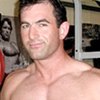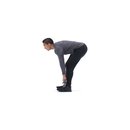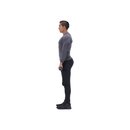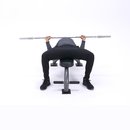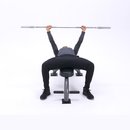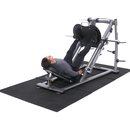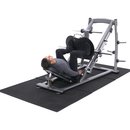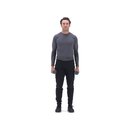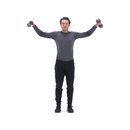The overarching goal for most bodybuilders is to gain as much muscle as possible through lifting the heaviest weights possible. When one gets to a certain point in their training, and heavier weights cannot be lifted, a plateau often ensues.
This will more than likely halt progress until further increases can be made. Often, further increases in weight can not be made unless the correct foundations are in place. Sure, training for a number of years and making steady gains is great, but to really take the next step, and pile on the size, power assistance exercises may need to be employed. These strengthen the tendons and ligaments which support the muscles one is wanting to develop.
Power assistance exercises were used back in the 50s and 60s by great power lifters such as Chuck Sipes and Doug Hepburn, to help them lift phenomenal weights without the aid of anabolic substances, state of the art nutrition and supplement programs and lifting shirts.
In fact, powerlifters and power bodybuilders (those who incorporate power lifting principles into their bodybuilding program) really need to focus on developing tendon and ligament strength to lift the weights they lift. Power bodybuilders are typified by their extremely thick and dense musculature and only get this way through lifting well beyond what their non-power bodybuilding counterparts lift.
This requires a tremendous amount of power, stemming from strong tendons and ligaments.
Legendary power-lifter Ted Arcidi, himself no stranger to dense muscle mass, agrees that specializing in exercises that build greater tendon and ligament strength will enhance power and overall size.
Incorporating power assistance exercises into ones bodybuilding program will go a long way toward breaking through that dreaded plateau. Before explaining exactly what power assistance exercises are and how to implement them, a short explanation on the structure and function of tendons and ligaments is required...
Why The Importance Of Tendons and Ligaments?
Tendons and ligaments are essential in terms of weight training. They are very similar in composition, serve different functions and significantly assist with the process of muscular extension and contraction. Both are designed to passively stabilize joints. A tendon connects the ends of a muscle belly to bone tissue and can be likened to a tough strap-like cord.
When properly developed, a tendon has good elasticity and is strong and capable of great power. Tendons essentially cause the bone to move as they transmit tensile load produced by the muscles. A tendon will strengthen concurrently with the muscle usually but if great increases in weight are desired they need to be targeted separately. Tendon injuries are relatively common in those who use anabolic steroids and increase muscle, but not tendon, strength at a phenomenal rate.
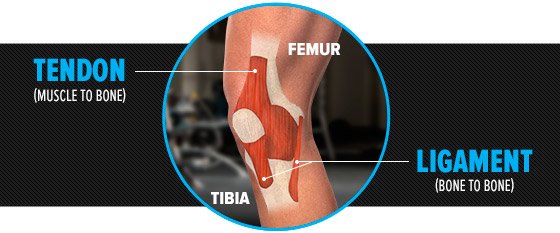
{{caption}}
This illustrates the need to train them independent of muscle under these circumstances. On the other hand, tendons can become stronger than muscles and muscle ruptures can result. This is why it is important, when looking to increase weight lifted, to incorporate specific tendon training power assistance exercises) into an established muscle training routine rather than training exclusively with heavy weights or with power assistance exercises or weights that can be handled with ease.
With either approach tendon or muscle ruptures could occur and, besides, massive increases in weight will not be realised if these approaches are not used concurrently. Tendon ruptures are very serious, with a 50 week full recovery rate being about average.
Ligaments are tougher cord-like fibres with greater flexibility. They tie, or bind, bones together at joints and allow for movement in a specific direction.
Tendons and Ligaments Are Composed Of Two Fibre Types
Collagen provides strength and stiffness while elastin allows the joint to extend. Given the vitalness of tendons and ligaments in terms of training with maximal weights, it is important to strengthen them in preparation for unprecedentedly heavy weight training sessions - the kind of sessions that take muscle-building to the next level.
The Program
To develop great power, and consequently muscle size, it is important to specialize with exercises that stress the major muscle groups such as the thighs, chest, back and shoulders. Squats, bench press, dead-lifts, bent rowing and barbell shoulder presses are obvious examples of compound exercise that stress these muscle groups.
However, to develop strength in the tendons and ligaments, which will lead to increased strength in subsequent work-outs and ultimately greater muscle gains, the idea is to execute these movements over a shorter range of motion.
The short range movements will allow more weight to be lifted and a greater emphasis will be placed on tendons and ligaments rather than the muscle bellies.
The idea with short range movements is to progressively increase the distance the weight has to travel over time. An example of a short range bench press will illustrate this point. The use of a power rack, where the weight can be rested on a cross bar, is ideal. Most gyms will have one of these. (shown to right)
First, place a flat bench under the power rack set the bar to a position where the negative part of the movement, beginning with arms extended completely, will be about five inches. Use a weight that is sufficiently heavy (150% of ones one repetition maximum would be best but this could be determined by the trainer) and complete six repetitions. A good rule of thumb is to lower the bar every week by one sixth of ones total arm length (a 24 inch arm divided by six equals four inches, for example).
EXERCISE 1. Barbell Squat

{{caption}}
Use the bench press strategy for squats also. Set the power rack bar and squat partially (about four inches). Knee wraps may need to be worn as the weight will be unaccustomed and injury could occur.
EXERCISE 2. Push Press - Behind the Neck

{{caption}}
Be very careful this exercise as it is contraindicated in many respects. Impingement of the rotator cuff complex can occur in those susceptible. It is an excellent movement nevertheless for strengthening tendons and ligaments in the triceps and shoulder girdle.
EXERCISE 3. Lying Triceps Press

{{caption}}
Ideal for optimal triceps development, this exercise can be performed within the confines of a power rack also. Use the same principle outlined for the squats, bench press and behind the neck press.
Sample Workout Routine

BodyFit
$6.99/month- 2,500+ expert-created single workouts
- 3,500+ how-to exercise videos
- Detailed workout instruction
- Step-by-step workout tips
- Training at gym or at home
- Access to Workout Plans
- Access to Bodyfit App
- Store Discounts
Already have a Bodybuilding.com account with BodyFit? Sign In

What comes with BodyFit?

- Instructional Videos
Don't risk doing a workout improperly! Avoid injury and keep your form in check with in-depth instructional videos.

- How-to Images
View our enormous library of workout photos and see exactly how each exercise should be done before you give it a shot.

- Step-by-Step Instructions
Quickly read through our step-by-step directions to ensure you're doing each workout correctly the first time, every time.

BodyFit
$6.99/month- 2,500+ expert-created single workouts
- 3,500+ how-to exercise videos
- Detailed workout instruction
- Step-by-step workout tips
- Training at gym or at home
- Access to Workout Plans
- Access to Bodyfit App
- Store Discounts
Already have a Bodybuilding.com account with BodyFit? Sign In

What comes with BodyFit?

- Instructional Videos
Don't risk doing a workout improperly! Avoid injury and keep your form in check with in-depth instructional videos.

- How-to Images
View our enormous library of workout photos and see exactly how each exercise should be done before you give it a shot.

- Step-by-Step Instructions
Quickly read through our step-by-step directions to ensure you're doing each workout correctly the first time, every time.
Wednesday: Rest

BodyFit
$6.99/month- 2,500+ expert-created single workouts
- 3,500+ how-to exercise videos
- Detailed workout instruction
- Step-by-step workout tips
- Training at gym or at home
- Access to Workout Plans
- Access to Bodyfit App
- Store Discounts
Already have a Bodybuilding.com account with BodyFit? Sign In

What comes with BodyFit?

- Instructional Videos
Don't risk doing a workout improperly! Avoid injury and keep your form in check with in-depth instructional videos.

- How-to Images
View our enormous library of workout photos and see exactly how each exercise should be done before you give it a shot.

- Step-by-Step Instructions
Quickly read through our step-by-step directions to ensure you're doing each workout correctly the first time, every time.
Friday: Rest

BodyFit
$6.99/month- 2,500+ expert-created single workouts
- 3,500+ how-to exercise videos
- Detailed workout instruction
- Step-by-step workout tips
- Training at gym or at home
- Access to Workout Plans
- Access to Bodyfit App
- Store Discounts
Already have a Bodybuilding.com account with BodyFit? Sign In

What comes with BodyFit?

- Instructional Videos
Don't risk doing a workout improperly! Avoid injury and keep your form in check with in-depth instructional videos.

- How-to Images
View our enormous library of workout photos and see exactly how each exercise should be done before you give it a shot.

- Step-by-Step Instructions
Quickly read through our step-by-step directions to ensure you're doing each workout correctly the first time, every time.
Conclusion
These exercises can be incorporated into ones existing training regime. In fact this is an ideal time as the muscles, tendons and ligaments will be warm and well lubricated. Although the exercises listed are highly recommended, one can experiment and devise their own tendon and ligament strengthening program by modifying the exercises they normally use in addition to the ones suggested.
Remember, with this program weights are to be maximal and repetitions are to be kept relatively low (up to six). This will ensure that the tendinous connections at the insertions of each muscle are strengthened, and a corresponding increase in muscle size witnessed.
